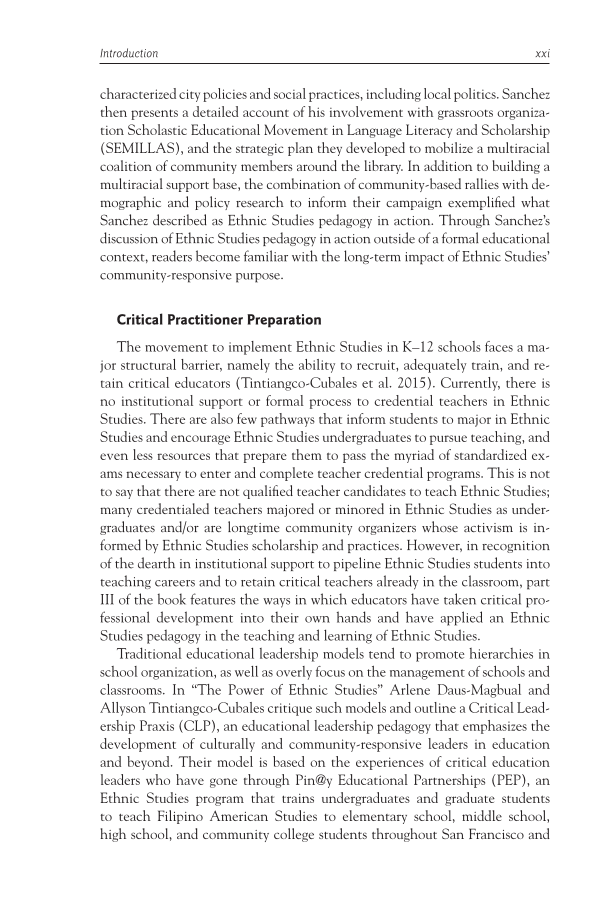Introduction xxi characterized city policies and social practices, including local politics. Sanchez then presents a detailed account of his involvement with grassroots organiza- tion Scholastic Educational Movement in Language Literacy and Scholarship (SEMILLAS), and the strategic plan they developed to mobilize a multiracial coalition of community members around the library. In addition to building a multiracial support base, the combination of community-based rallies with de- mographic and policy research to inform their campaign exemplified what Sanchez described as Ethnic Studies pedagogy in action. Through Sanchez’s discussion of Ethnic Studies pedagogy in action outside of a formal educational context, readers become familiar with the long-term impact of Ethnic Studies’ community-responsive purpose. Critical Practitioner Preparation The movement to implement Ethnic Studies in K–12 schools faces a ma- jor structural barrier, namely the ability to recruit, adequately train, and re- tain critical educators (Tintiangco-Cubales et al. 2015). Currently, there is no institutional support or formal process to credential teachers in Ethnic Studies. There are also few pathways that inform students to major in Ethnic Studies and encourage Ethnic Studies undergraduates to pursue teaching, and even less resources that prepare them to pass the myriad of standardized ex- ams necessary to enter and complete teacher credential programs. This is not to say that there are not qualified teacher candidates to teach Ethnic Studies many credentialed teachers majored or minored in Ethnic Studies as under- graduates and/or are longtime community organizers whose activism is in- formed by Ethnic Studies scholarship and practices. However, in recognition of the dearth in institutional support to pipeline Ethnic Studies students into teaching careers and to retain critical teachers already in the classroom, part III of the book features the ways in which educators have taken critical pro- fessional development into their own hands and have applied an Ethnic Studies pedagogy in the teaching and learning of Ethnic Studies. Traditional educational leadership models tend to promote hierarchies in school organization, as well as overly focus on the management of schools and classrooms. In “The Power of Ethnic Studies” Arlene Daus-Magbual and Allyson Tintiangco-Cubales critique such models and outline a Critical Lead- ership Praxis (CLP), an educational leadership pedagogy that emphasizes the development of culturally and community-responsive leaders in education and beyond. Their model is based on the experiences of critical education leaders who have gone through Pin@y Educational Partnerships (PEP), an Ethnic Studies program that trains undergraduates and graduate students to teach Filipino American Studies to elementary school, middle school, high school, and community college students throughout San Francisco and
Document Details My Account Print multiple pages
Print
You have printed 0 times in the last 24 hours.
Your print count will reset on at .
You may print 0 more time(s) before then.
You may print a maximum of 0 pages at a time.




































































































































































































































































































































































































































































































































































































































































































